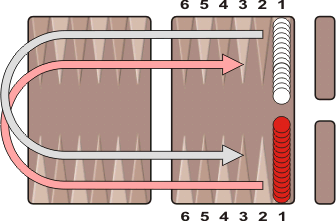![[Backgammon Galore!]](/gif/GaloreButton.gif)
|
|
Backgammon Variants Setup: Each player starts with fifteen checkers on the opposing player's one-point.
Object: The object of the game is to move all of your checkers around the board to your own home table and then bear them off. The first player to bear off all of his checkers wins the game. To start: Each player rolls one die and the higher number goes first. That player then rolls both dice again to begin his first turn. Movement: The roll of the dice indicates how many points, or pips, the player is to move his checkers. The following rules apply:
Acey-deucey: If you roll 1 and 2 (acey-deucey), this is what happens:
That is the end of your turn; you do not get to roll again as in other forms of acey-deucey. Hitting: A checker sitting alone on a point is called a blot. If an opposing checker lands on a blot, the blot is hit and placed on the bar. Entering from the bar: Any time you have one or more checkers on the bar, your first obligation is to reenter those checker(s) into the opponent's home board. You reenter a checker by moving it to an open point corresponding to one of the numbers on the rolled dice. If you are able to enter some but not all of your checkers on the bar, you must enter as many as you can then give up the remainder of your turn. Compulsory hit: At the end of his turn, a player may name one of his own blots to be hit. This request must be made before the opponent rolls the dice. The opponent must then hit the named blot if possible on his turn. If there is more than one way to hit the named blot, the opponent is free to hit it in the manner he chooses. Bearing Off: Once you have moved all fifteen of your checkers into your home board, you may begin bearing off. You bear off a checker by rolling a number that corresponds to the point on which the checker resides, then removing it from the board. If there is no checker on the point indicated by the roll, you must make a legal move using a checker on a higher-numbered point. If there are no checkers on higher-numbered points, you must remove a checker from the highest point that has a checker. Scoring: The winner of the game scores one point. There are no gammons or backgammons. There is no doubling cube.
References
|
![]()
Backgammon Galore : Variants

